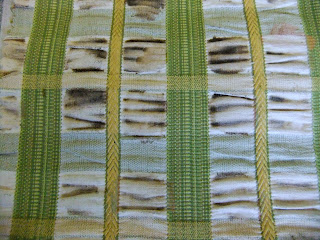Research point: This technique would be interesting to integrate with some of the other stitching techniques. 3-D sculptures could also be made, possibly incorporating armatures. It could also be used to build up surfaces with stitched layers of fabric on top.
Another interesting textile product was used for the next project. Fibre-etch is a discharge liquid used for devore and similar techniques where the fabric is chemically burned away to leave a permanent pattern on the fabric. Silk velvet is a particularly good subject for this technique as the pile is quite distinctive from the background fabric.
I hand-dyed a piece of silk velvet for this sample using Procion fibre reactive dyes and a cold water dyeing method. Dyes were dissolved in water and applied at random using squirty bottles to the damp fabric which had been pre-soaked in an alkali (sodium carbonate). The fabric was left overnight then rinsed and allowed to dry.
I used a stencil from an earlier project for this sample, painting the Fiber-etch onto the fabric using the stencil as a template. I created a new pattern by re-arranging the stencil and repeating the application process.
After leaving the Fiber-etch in place for around 15 minutes, it was rinsed off. The velvet pile came away where the Fiber-etch had been applied, leaving a 3-dimensional effect.
Thoughts: Unfortunately, I must have left the Fiber-etch on for too long as the product completely ate away the background fabric in places which wasn't the effect I was aiming for. In areas where the process had been successful it gave nice crisp edges to the burnt away areas and created really pleasing effects. Clearly there is a need to practice with a) timing, b) amount of product used and c) the durability of the fabric being used.
Further research: A further use for this product might be deliberately to burn away the entire fabric, however, this would most likely need to be stablised with stitching to prevent fraying or further burnout.
I also experimented with Fiber-etch on a much stronger, cotton and linen furnishing fabric.
Despite leaving the fabric for much longer (45 mins) it was noticeable that the fabric was much harder to burnt out (supporting conclusion c) above). Without a distinct background (unlike the velvet where the pile is cotton, the background silk) the fibre did indeed burn away completely (also supporting my theory above).
In most cases I had to rip the fabric to really open up and there was some fraying, although this was an intentional result to give the fabric a rustic feel.
I completed the piece by adding roughly cut strips of the same fabric and weaving these through the burnt out holes.
I also experimented with stitched surface texture:
Pleating - plain cotton fabric and white cotton stitching to create tight, narrow pleats.
Stitching and drawn thread on fine, grey chiffon. This was interesting as the fabric already had a differential weave with thicker and finer sections.
I also took two very different materials, nylon stocking fabric and roughly-cut strips of a polyester satin lining fabric. I stretched the nylon over an embroidery hoop to give it sufficient tension to carry out a "hooky-proggy" locker-hooking style embellishment. I used a locker hook to poke narrow strips of the poly satin through the fabric. I took my inspiration from the air plant I had used in earlier projects as I thought this method of fabric manipulation would replicate highly textural qualities of the air plant. The shape and the textures of the loops did capture what I was looking for, however, an unexpected bonus was that the fabric naturally frayed giving softer, fuzzy edges. This proved to be very successful in capturing the many fine lines of the air plant that I hadn't anticipated. Normally I prefer fabrics that don't fray so this will be an interesting property to explore further in future projects.





























